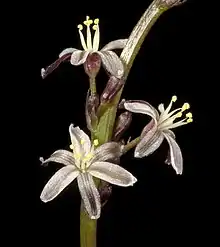Caesia micrantha
Caesia micrantha (common name – pale grass-lily)[1] is a species of flowering plant in the subfamily Hemerocallidaceae native to Western Australia.[2]
| Caesia micrantha | |
|---|---|
 | |
| Scientific classification | |
| Kingdom: | Plantae |
| Clade: | Tracheophytes |
| Clade: | Angiosperms |
| Clade: | Monocots |
| Order: | Asparagales |
| Family: | Asphodelaceae |
| Subfamily: | Hemerocallidoideae |
| Genus: | Caesia |
| Species: | C. micrantha |
| Binomial name | |
| Caesia micrantha | |
Description
Caesia micrantha has fibrous roots. The leaves are 15 to 65 cm long, with the leaf blade being 3 to 10 mm wide, and the sheath sometimes persisting as fibres. The inflorescence is 25–60 cm with few to many branches and lower bracts which are up to 35 cm long. The flower clusters contain from 1 to 4 flowers and are often paired. The capsule generally has three lobes which are 2.5 to 5 mm wide, and the seeds are from 1.3 to 1.7 mm wide.[2]
Distribution and habitat
It grows on many different soil types and is widespread in the south-west of Western Australia both on the ranges and the coastal plain from Albany to Geraldton.[2]
Conservation status
Under Western Australian conservation law, it is listed as "Not Threatened".[1]
Taxonomy and etymology
In 1840, the species was first described by John Lindley[3][4] The specific epithet, micrantha is an adjective derived from the Greek, mikros ("small" or "little") and anthos ("flower") meaning "having small flowers", or "small-flowered".[5]
References
- "Caesia micrantha". FloraBase. Western Australian Government Department of Biodiversity, Conservation and Attractions.
- R.J.F.Henderson (2020). "Caesia micrantha". Flora of Australia. Australian Biological Resources Study, Department of Agriculture, Water and the Environment. Retrieved 19 July 2020.
- "Caesia micrantha". Australian Plant Name Index, IBIS database. Centre for Plant Biodiversity Research, Australian Government.
- Lindley, J. (1840). A Sketch of the Vegetation of the Swan River Colony. pp. lvii.
- "micranthus,-a,-um". plantillustrations.org. Retrieved 19 July 2020.